Abstract
The gastrointestinal tract, besides being the organ responsible for nutrient absorption, is also a metabolic and immunological system, functioning as an effective barrier against endotoxin and bacteria in the intestinal lumen. The passage of viable bacteria from the gastrointestinal tract through the epithelial mucosa is called bacterial translocation. Equally important may be the passage of bacterial endotoxin through the mucosal barrier. This article reviews the evidence that translocation of both endotoxin and bacteria is of clinical significance. It summarises recent published works indicating that translocation of endotoxin in minute amounts is a physiological important phenomenon to boost the reticuloendothelial system (RES), especially the Kupffer cells, in the liver. Breakdown of both the mucosal barrier and the RES capacity results in systemic endotoxaemia. Systemic endotoxaemia results in organ dysfunction, impairs the mucosal barrier, the clotting system, the immune system, and depresses Kupffer cell function. If natural defence mechanisms such as lipopolysaccharide binding protein, high density lipoprotein, in combination with the RES, do not respond properly, dysfunction of the gut barrier results in bacterial translocation. Extensive work on bacterial translocation has been performed in animal models and occurs notably in haemorrhagic shock, thermal injury, protein malnutrition, endotoxaemia, trauma, and intestinal obstruction. It is difficult to extrapolate these results to humans and its clinical significance is not clear. The available data show that the resultant infection remains important in the development of sepsis, especially in the critically ill patient. Uncontrolled infection is, however, neither necessary nor sufficient to account for the development of multiple organ failure. A more plausible sequelae is that bacterial translocation is a later phenomenon of multiple organ failure, and not its initiator. It is hypothesized that multiple organ failure is more probably triggered by the combination of tissue damage and systemic endotoxaemia. Endotoxaemia, as seen in trauma patients especially during the first 24 hours, in combination with tissue elicits a systemic inflammation, called Schwartzmann reaction. Interferon gamma, a T cell produced cytokine, is thought to play a pivotal part in the pathogenesis of this reaction. This reaction might occur only if the endotoxin induced cytokines like tumour necrosis factor and interleukin 1, act on target cells prepared by interferon gamma. After exposure to interferon gamma target cells become more sensitive to stimuli like endotoxin, thus boosting the inflammatory cycle. Clearly, following this line of reasoning, minor tissue damage or retroperitoneal haematoma combined with systemic endotoxaemia could elicit this reaction. The clinically observed failure of multiple organ systems might thus be explained by the interaction of tissue necrosis and high concentrations of endotoxin because of translocation. Future therapeutic strategies could therefore focus more on binding endotoxin in the gut before the triggering event, for example before major surgery. Such a strategy could be combined with the start of early enteral feeding, which has been shown in animal studies to have a beneficial effect on intestinal mucosal barrier function and in traumatized patients to reduce the incidence of septic complications.
Full text
PDF
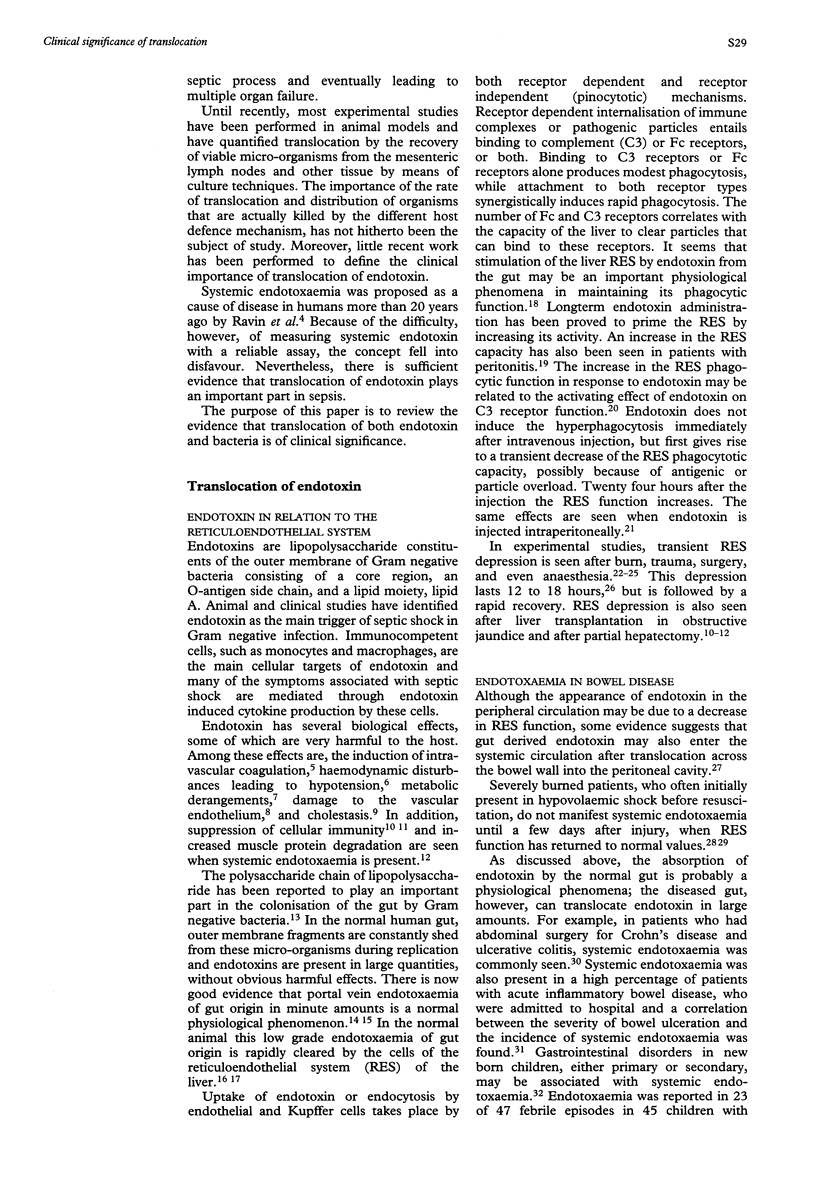

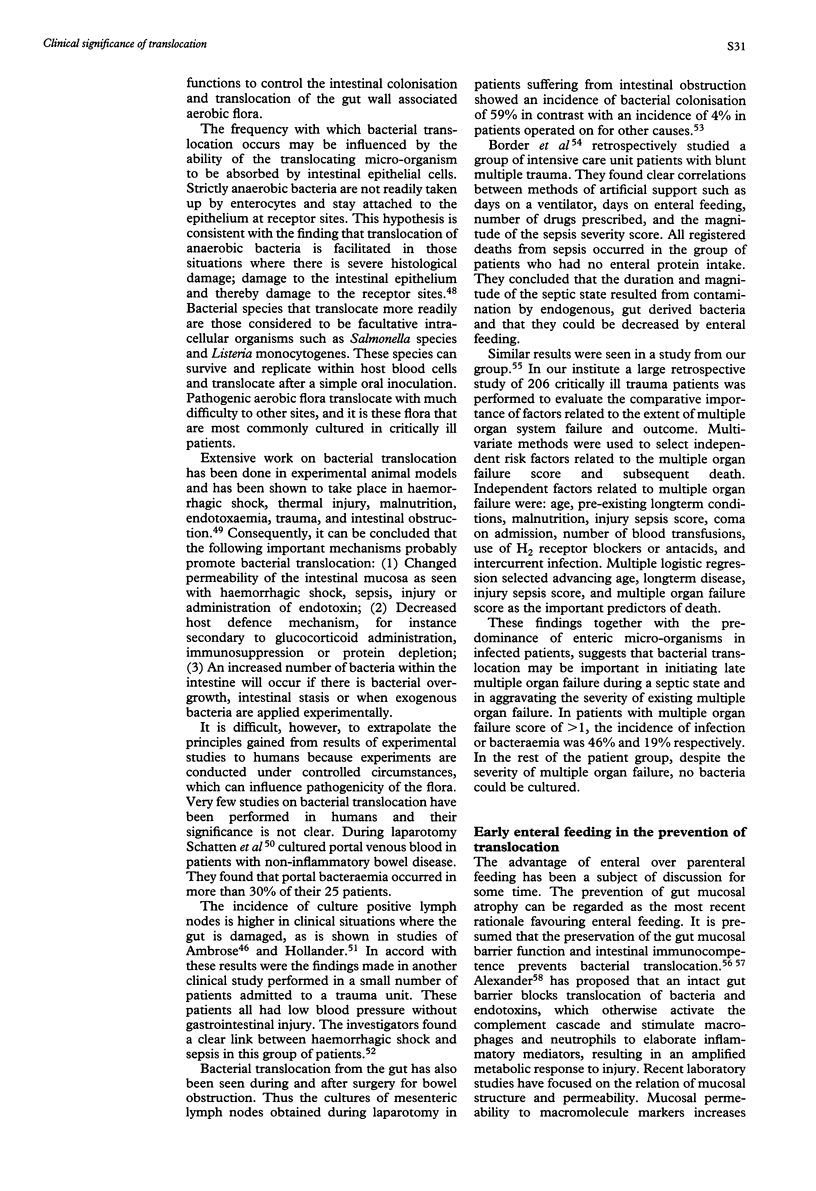
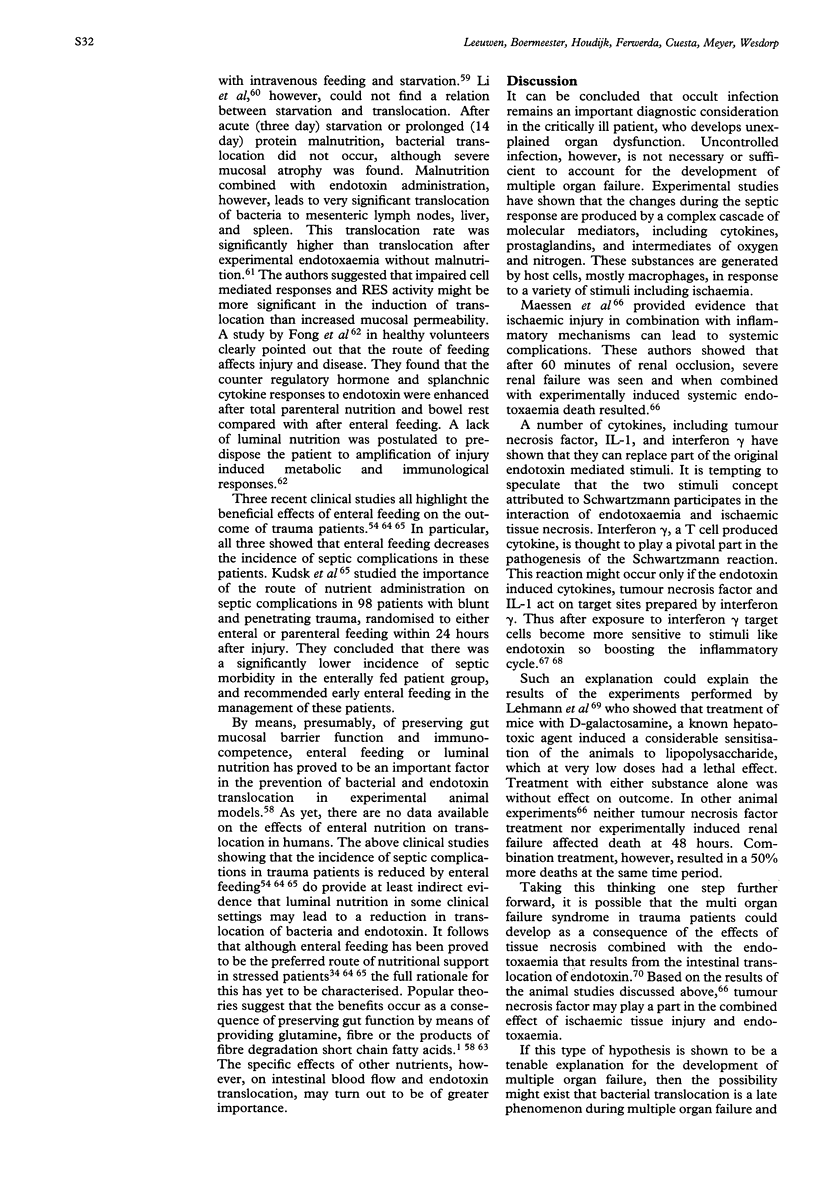
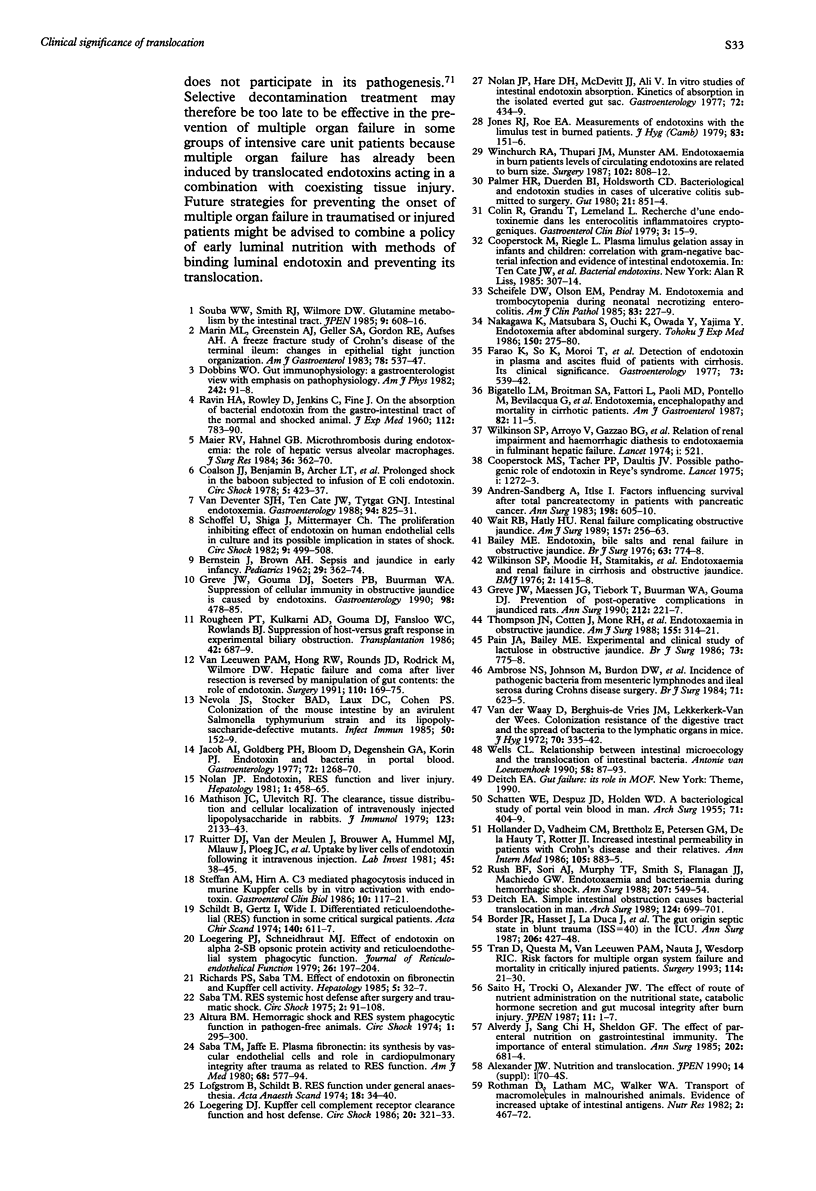
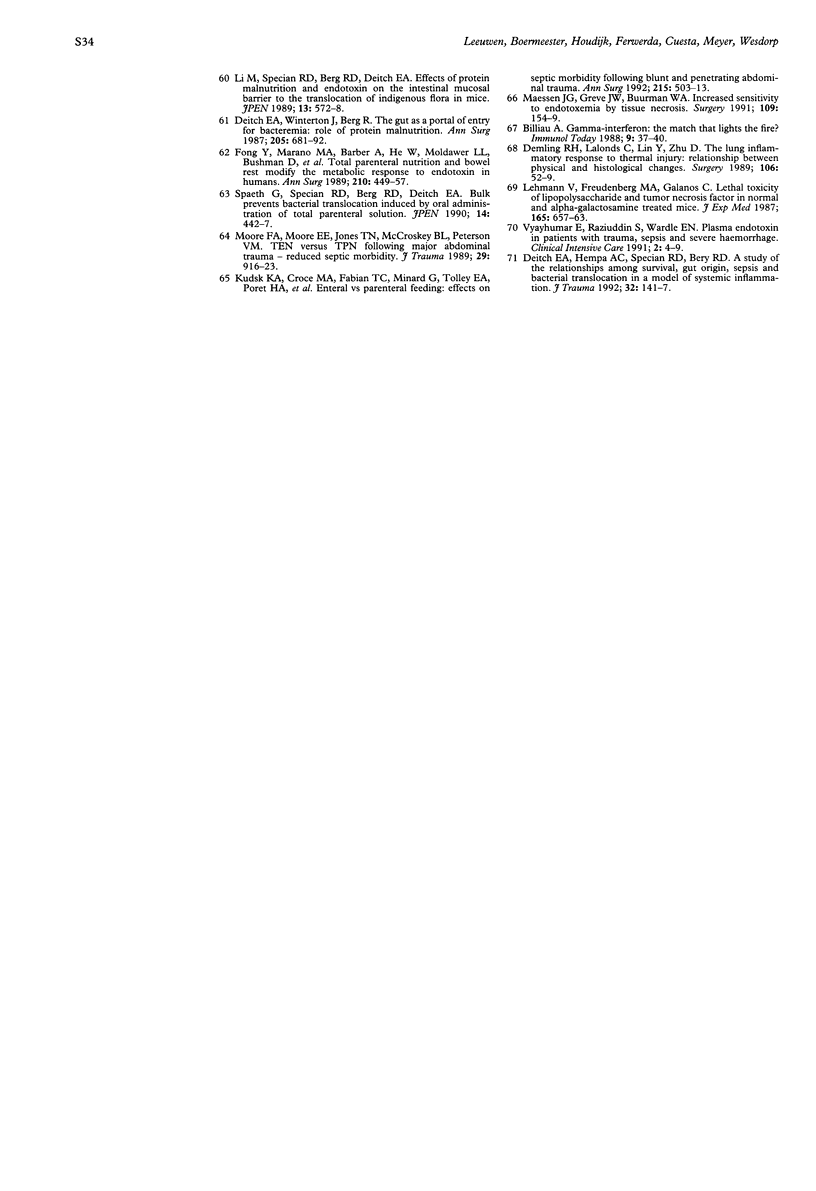
Selected References
These references are in PubMed. This may not be the complete list of references from this article.
- Alverdy J., Chi H. S., Sheldon G. F. The effect of parenteral nutrition on gastrointestinal immunity. The importance of enteral stimulation. Ann Surg. 1985 Dec;202(6):681–684. doi: 10.1097/00000658-198512000-00003. [DOI] [PMC free article] [PubMed] [Google Scholar]
- Ambrose N. S., Johnson M., Burdon D. W., Keighley M. R. Incidence of pathogenic bacteria from mesenteric lymph nodes and ileal serosa during Crohn's disease surgery. Br J Surg. 1984 Aug;71(8):623–625. doi: 10.1002/bjs.1800710821. [DOI] [PubMed] [Google Scholar]
- Andrén-Sandberg A., Ihse I. Factors influencing survival after total pancreatectomy in patients with pancreatic cancer. Ann Surg. 1983 Nov;198(5):605–610. doi: 10.1097/00000658-198311000-00008. [DOI] [PMC free article] [PubMed] [Google Scholar]
- Bailey M. E. Endotoxin, bile salts and renal function in obstructive jaundice. Br J Surg. 1976 Oct;63(10):774–778. doi: 10.1002/bjs.1800631011. [DOI] [PubMed] [Google Scholar]
- Bigatello L. M., Broitman S. A., Fattori L., Di Paoli M., Pontello M., Bevilacqua G., Nespoli A. Endotoxemia, encephalopathy, and mortality in cirrhotic patients. Am J Gastroenterol. 1987 Jan;82(1):11–15. [PubMed] [Google Scholar]
- Billiau A. Gamma-interferon: the match that lights the fire? Immunol Today. 1988 Feb;9(2):37–40. doi: 10.1016/0167-5699(88)91256-X. [DOI] [PubMed] [Google Scholar]
- Border J. R., Hassett J., LaDuca J., Seibel R., Steinberg S., Mills B., Losi P., Border D. The gut origin septic states in blunt multiple trauma (ISS = 40) in the ICU. Ann Surg. 1987 Oct;206(4):427–448. doi: 10.1097/00000658-198710000-00004. [DOI] [PMC free article] [PubMed] [Google Scholar]
- Coalson J. J., Benjamin B., Archer L. T., Beller B., Gilliam C. L., Taylor F. B., Hinshaw L. B. Prolonged shock in the baboon subjected to infusion of E. coli endotoxin. Circ Shock. 1978;5(4):423–437. [PubMed] [Google Scholar]
- Colin R., Grancher T., Lemeland J. F., Hecketsweiler P., Galmiche J. P., Le Grix A., Geffroy Y. Recherche d'une endotoxinémie dans les entéro-colites inflammatoires cryptogénétiques. Gastroenterol Clin Biol. 1979 Jan;3(1):15–19. [PubMed] [Google Scholar]
- Cooperstock M. S., Tucker R. P., Baublis J. V. Possible pathogenic role of endotoxin in Reye's syndrome. Lancet. 1975 Jun 7;1(7919):1272–1274. doi: 10.1016/s0140-6736(75)92553-2. [DOI] [PubMed] [Google Scholar]
- Deitch E. A., Kemper A. C., Specian R. D., Berg R. D. A study of the relationship among survival, gut-origin sepsis, and bacterial translocation in a model of systemic inflammation. J Trauma. 1992 Feb;32(2):141–147. [PubMed] [Google Scholar]
- Deitch E. A. Simple intestinal obstruction causes bacterial translocation in man. Arch Surg. 1989 Jun;124(6):699–701. doi: 10.1001/archsurg.1989.01410060065013. [DOI] [PubMed] [Google Scholar]
- Deitch E. A., Winterton J., Li M., Berg R. The gut as a portal of entry for bacteremia. Role of protein malnutrition. Ann Surg. 1987 Jun;205(6):681–692. doi: 10.1097/00000658-198706000-00010. [DOI] [PMC free article] [PubMed] [Google Scholar]
- Demling R. H., LaLonde C., Liu Y. P., Zhu D. G. The lung inflammatory response to thermal injury: relationship between physiologic and histologic changes. Surgery. 1989 Jul;106(1):52–59. [PubMed] [Google Scholar]
- Fong Y. M., Marano M. A., Barber A., He W., Moldawer L. L., Bushman E. D., Coyle S. M., Shires G. T., Lowry S. F. Total parenteral nutrition and bowel rest modify the metabolic response to endotoxin in humans. Ann Surg. 1989 Oct;210(4):449–457. doi: 10.1097/00000658-198910000-00005. [DOI] [PMC free article] [PubMed] [Google Scholar]
- Greve J. W., Gouma D. J., Soeters P. B., Buurman W. A. Suppression of cellular immunity in obstructive jaundice is caused by endotoxins: a study with germ-free rats. Gastroenterology. 1990 Feb;98(2):478–485. doi: 10.1016/0016-5085(90)90841-n. [DOI] [PubMed] [Google Scholar]
- Greve J. W., Maessen J. G., Tiebosch T., Buurman W. A., Gouma D. J. Prevention of postoperative complications in jaundiced rats. Internal biliary drainage versus oral lactulose. Ann Surg. 1990 Aug;212(2):221–227. doi: 10.1097/00000658-199008000-00018. [DOI] [PMC free article] [PubMed] [Google Scholar]
- Hollander D., Vadheim C. M., Brettholz E., Petersen G. M., Delahunty T., Rotter J. I. Increased intestinal permeability in patients with Crohn's disease and their relatives. A possible etiologic factor. Ann Intern Med. 1986 Dec;105(6):883–885. doi: 10.7326/0003-4819-105-6-883. [DOI] [PubMed] [Google Scholar]
- Jacob A. I., Goldberg P. K., Bloom N., Degenshein G. A., Kozinn P. J. Endotoxin and bacteria in portal blood. Gastroenterology. 1977 Jun;72(6):1268–1270. [PubMed] [Google Scholar]
- Jones R. J., Roe E. A. Measurement of endotoxins with the limulus test in burned patients. J Hyg (Lond) 1979 Aug;83(1):151–156. doi: 10.1017/s0022172400025924. [DOI] [PMC free article] [PubMed] [Google Scholar]
- Kudsk K. A., Croce M. A., Fabian T. C., Minard G., Tolley E. A., Poret H. A., Kuhl M. R., Brown R. O. Enteral versus parenteral feeding. Effects on septic morbidity after blunt and penetrating abdominal trauma. Ann Surg. 1992 May;215(5):503–513. doi: 10.1097/00000658-199205000-00013. [DOI] [PMC free article] [PubMed] [Google Scholar]
- Lehmann V., Freudenberg M. A., Galanos C. Lethal toxicity of lipopolysaccharide and tumor necrosis factor in normal and D-galactosamine-treated mice. J Exp Med. 1987 Mar 1;165(3):657–663. doi: 10.1084/jem.165.3.657. [DOI] [PMC free article] [PubMed] [Google Scholar]
- Li M., Specian R. D., Berg R. D., Deitch E. A. Effects of protein malnutrition and endotoxin on the intestinal mucosal barrier to the translocation of indigenous flora in mice. JPEN J Parenter Enteral Nutr. 1989 Nov-Dec;13(6):572–578. doi: 10.1177/0148607189013006572. [DOI] [PubMed] [Google Scholar]
- Loegering D. J. Kupffer cell complement receptor clearance function and host defense. Circ Shock. 1986;20(4):321–333. [PubMed] [Google Scholar]
- Loegering D. J., Schneidkraut M. J. Effect of endotoxin on alpha 2 SB-opsonic protein activity and reticuloendothelial system phagocytic function. J Reticuloendothel Soc. 1979 Aug;26(2):197–204. [PubMed] [Google Scholar]
- Löfström B., Schildt B. Reticuloendothelial function under general anaesthesia. Acta Anaesthesiol Scand. 1974;18(1):34–40. doi: 10.1111/j.1399-6576.1974.tb00697.x. [DOI] [PubMed] [Google Scholar]
- Maessen J. G., Greve J. W., Buurman W. A. Increased sensitivity to endotoxemia by tissue necrosis. Surgery. 1991 Feb;109(2):154–159. [PubMed] [Google Scholar]
- Maier R. V., Hahnel G. B. Microthrombosis during endotoxemia: potential role of hepatic versus alveolar macrophages. J Surg Res. 1984 Apr;36(4):362–370. doi: 10.1016/0022-4804(84)90112-4. [DOI] [PubMed] [Google Scholar]
- Marin M. L., Greenstein A. J., Geller S. A., Gordon R. E., Aufses A. H., Jr A freeze fracture study of Crohn's disease of the terminal ileum: changes in epithelial tight junction organization. Am J Gastroenterol. 1983 Sep;78(9):537–547. [PubMed] [Google Scholar]
- Mathison J. C., Ulevitch R. J. The clearance, tissue distribution, and cellular localization of intravenously injected lipopolysaccharide in rabbits. J Immunol. 1979 Nov;123(5):2133–2143. [PubMed] [Google Scholar]
- Moore F. A., Moore E. E., Jones T. N., McCroskey B. L., Peterson V. M. TEN versus TPN following major abdominal trauma--reduced septic morbidity. J Trauma. 1989 Jul;29(7):916–923. doi: 10.1097/00005373-198907000-00003. [DOI] [PubMed] [Google Scholar]
- Nevola J. J., Stocker B. A., Laux D. C., Cohen P. S. Colonization of the mouse intestine by an avirulent Salmonella typhimurium strain and its lipopolysaccharide-defective mutants. Infect Immun. 1985 Oct;50(1):152–159. doi: 10.1128/iai.50.1.152-159.1985. [DOI] [PMC free article] [PubMed] [Google Scholar]
- Nolan J. P. Endotoxin, reticuloendothelial function, and liver injury. Hepatology. 1981 Sep-Oct;1(5):458–465. doi: 10.1002/hep.1840010516. [DOI] [PubMed] [Google Scholar]
- Nolan J. P., Hare D. K., McDevitt J. J., Ali M. V. In vitro studies of intestinal endotoxin absorption. I. Kinetics of absorption in the isolated everted gut sac. Gastroenterology. 1977 Mar;72(3):434–439. [PubMed] [Google Scholar]
- Pain J. A., Bailey M. E. Experimental and clinical study of lactulose in obstructive jaundice. Br J Surg. 1986 Oct;73(10):775–778. doi: 10.1002/bjs.1800731003. [DOI] [PubMed] [Google Scholar]
- Palmer K. R., Duerden B. I., Holdsworth C. D. Bacteriological and endotoxin studies in cases of ulcerative colitis submitted to surgery. Gut. 1980 Oct;21(10):851–854. doi: 10.1136/gut.21.10.851. [DOI] [PMC free article] [PubMed] [Google Scholar]
- RAVIN H. A., ROWLEY D., JENKINS C., FINE J. On the absorption of bacterial endotoxin from the gastro-intestinal tract of the normal and shocked animal. J Exp Med. 1960 Nov 1;112:783–792. doi: 10.1084/jem.112.5.783. [DOI] [PMC free article] [PubMed] [Google Scholar]
- Richards P. S., Saba T. M. Effect of endotoxin on fibronectin and Kupffer cell activity. Hepatology. 1985 Jan-Feb;5(1):32–37. doi: 10.1002/hep.1840050108. [DOI] [PubMed] [Google Scholar]
- Roughneen P. T., Kulkarni A. D., Gouma D. J., Fanslow W. C., Rowlands B. J. Suppression of host-versus-graft response in experimental biliary obstruction. Transplantation. 1986 Dec;42(6):687–689. doi: 10.1097/00007890-198612000-00021. [DOI] [PubMed] [Google Scholar]
- Ruiter D. J., van der Meulen J., Brouwer A., Hummel M. J., Mauw B. J., van der Ploeg J. C., Wisse E. Uptake by liver cells of endotoxin following its intravenous injection. Lab Invest. 1981 Jul;45(1):38–45. [PubMed] [Google Scholar]
- Rush B. F., Jr, Sori A. J., Murphy T. F., Smith S., Flanagan J. J., Jr, Machiedo G. W. Endotoxemia and bacteremia during hemorrhagic shock. The link between trauma and sepsis? Ann Surg. 1988 May;207(5):549–554. doi: 10.1097/00000658-198805000-00009. [DOI] [PMC free article] [PubMed] [Google Scholar]
- SCHATTEN W. E., DESPREZ J. D., HOLDEN W. D. A bacteriologic study of portal-vein blood in man. AMA Arch Surg. 1955 Sep;71(3):404–409. doi: 10.1001/archsurg.1955.01270150098011. [DOI] [PubMed] [Google Scholar]
- Saba T. M., Jaffe E. Plasma fibronectin (opsonic glycoprotein): its synthesis by vascular endothelial cells and role in cardiopulmonary integrity after trauma as related to reticuloendothelial function. Am J Med. 1980 Apr;68(4):577–594. doi: 10.1016/0002-9343(80)90310-1. [DOI] [PubMed] [Google Scholar]
- Saito H., Trocki O., Alexander J. W., Kopcha R., Heyd T., Joffe S. N. The effect of route of nutrient administration on the nutritional state, catabolic hormone secretion, and gut mucosal integrity after burn injury. JPEN J Parenter Enteral Nutr. 1987 Jan-Feb;11(1):1–7. doi: 10.1177/014860718701100101. [DOI] [PubMed] [Google Scholar]
- Scheifele D. W., Olsen E. M., Pendray M. R. Endotoxinemia and thrombocytopenia during neonatal necrotizing enterocolitis. Am J Clin Pathol. 1985 Feb;83(2):227–229. doi: 10.1093/ajcp/83.2.227. [DOI] [PubMed] [Google Scholar]
- Schildt B., Gertz I., Wide L. Differentiated reticuloendothelial system (res) function in some critical surgical conditions. Acta Chir Scand. 1974;140(8):611–617. [PubMed] [Google Scholar]
- Schöffel U., Shiga J., Mittermayer C. The proliferation-inhibiting effect of endotoxin on human endothelial cells in culture and its possible implication in states of shock. Circ Shock. 1982;9(5):499–508. [PubMed] [Google Scholar]
- Souba W. W., Smith R. J., Wilmore D. W. Glutamine metabolism by the intestinal tract. JPEN J Parenter Enteral Nutr. 1985 Sep-Oct;9(5):608–617. doi: 10.1177/0148607185009005608. [DOI] [PubMed] [Google Scholar]
- Spaeth G., Specian R. D., Berg R. D., Deitch E. A. Bulk prevents bacterial translocation induced by the oral administration of total parenteral nutrition solution. JPEN J Parenter Enteral Nutr. 1990 Sep-Oct;14(5):442–447. doi: 10.1177/0148607190014005442. [DOI] [PubMed] [Google Scholar]
- Steffan A. M., Kirn A. C3-mediated phagocytosis induced in murine Kupffer cells by "in vitro" activation with endotoxin. Gastroenterol Clin Biol. 1986 Feb;10(2):117–121. [PubMed] [Google Scholar]
- Tarao K., So K., Moroi T., Ikeuchi T., Suyama T. Detection of endotoxin in plasma and ascitic fluid of patients with cirrhosis: its clinical significance. Gastroenterology. 1977 Sep;73(3):539–542. [PubMed] [Google Scholar]
- Thompson J. N., Cohen J., Moore R. H., Blenkharn J. I., McConnell J. S., Matkin J., Blumgart L. H. Endotoxemia in obstructive jaundice. Observations on cause and clinical significance. Am J Surg. 1988 Feb;155(2):314–321. doi: 10.1016/s0002-9610(88)80723-2. [DOI] [PubMed] [Google Scholar]
- Tran D. D., Cuesta M. A., van Leeuwen P. A., Nauta J. J., Wesdorp R. I. Risk factors for multiple organ system failure and death in critically injured patients. Surgery. 1993 Jul;114(1):21–30. [PubMed] [Google Scholar]
- Wait R. B., Kahng K. U. Renal failure complicating obstructive jaundice. Am J Surg. 1989 Feb;157(2):256–263. doi: 10.1016/0002-9610(89)90540-0. [DOI] [PubMed] [Google Scholar]
- Wells C. L. Relationship between intestinal microecology and the translocation of intestinal bacteria. Antonie Van Leeuwenhoek. 1990 Aug;58(2):87–93. doi: 10.1007/BF00422722. [DOI] [PubMed] [Google Scholar]
- Wilkinson S. P., Arroyo V., Gazzard B. G., Moodie H., Williams R. Relation of renal impairment and haemorrhagic diathesis to endotoxaemia in fulminant hepatic failure. Lancet. 1974 Mar 30;1(7857):521–524. doi: 10.1016/s0140-6736(74)92711-1. [DOI] [PubMed] [Google Scholar]
- Wilkinson S. P., Moodie H., Stamatakis J. D., Kakkar V. V., Williams R. Endotoxaemia and renal failure in cirrhosis and obstructive jaundice. Br Med J. 1976 Dec 11;2(6049):1415–1418. doi: 10.1136/bmj.2.6049.1415. [DOI] [PMC free article] [PubMed] [Google Scholar]
- Winchurch R. A., Thupari J. N., Munster A. M. Endotoxemia in burn patients: levels of circulating endotoxins are related to burn size. Surgery. 1987 Nov;102(5):808–812. [PubMed] [Google Scholar]
- van Deventer S. J., ten Cate J. W., Tytgat G. N. Intestinal endotoxemia. Clinical significance. Gastroenterology. 1988 Mar;94(3):825–831. doi: 10.1016/0016-5085(88)90261-2. [DOI] [PubMed] [Google Scholar]
- van Leeuwen P. A., Hong R. W., Rounds J. D., Rodrick M. L., Wilmore D. Hepatic failure and coma after liver resection is reversed by manipulation of gut contents: the role of endotoxin. Surgery. 1991 Aug;110(2):169–175. doi: 10.1016/0261-5614(91)90171-8. [DOI] [PubMed] [Google Scholar]
- van der Waaij D., Berghuis-de Vries J. M., Lekkerkerk-van der Wees Colonization resistance of the digestive tract and the spread of bacteria to the lymphatic organs in mice. J Hyg (Lond) 1972 Jun;70(2):335–342. doi: 10.1017/s0022172400022385. [DOI] [PMC free article] [PubMed] [Google Scholar]


